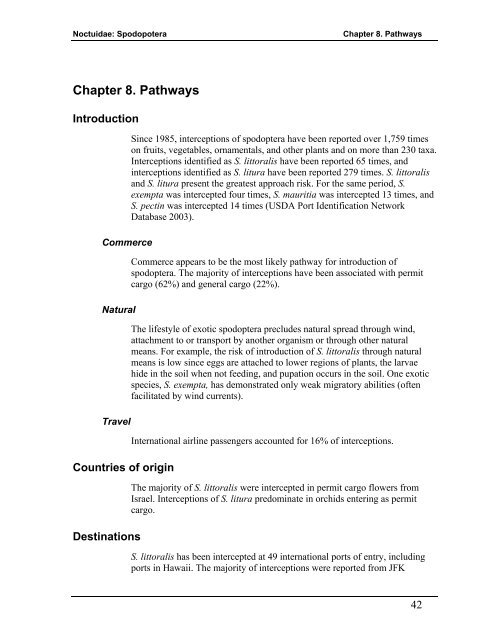New Pest Response Guidelines - Phytosanitary Resources
New Pest Response Guidelines - Phytosanitary Resources
New Pest Response Guidelines - Phytosanitary Resources
Create successful ePaper yourself
Turn your PDF publications into a flip-book with our unique Google optimized e-Paper software.
Noctuidae: Spodopotera<br />
Chapter 8. Pathways<br />
Chapter 8. Pathways<br />
Introduction<br />
Commerce<br />
Natural<br />
Travel<br />
Countries of origin<br />
Destinations<br />
Since 1985, interceptions of spodoptera have been reported over 1,759 times<br />
on fruits, vegetables, ornamentals, and other plants and on more than 230 taxa.<br />
Interceptions identified as S. littoralis have been reported 65 times, and<br />
interceptions identified as S. litura have been reported 279 times. S. littoralis<br />
and S. litura present the greatest approach risk. For the same period, S.<br />
exempta was intercepted four times, S. mauritia was intercepted 13 times, and<br />
S. pectin was intercepted 14 times (USDA Port Identification Network<br />
Database 2003).<br />
Commerce appears to be the most likely pathway for introduction of<br />
spodoptera. The majority of interceptions have been associated with permit<br />
cargo (62%) and general cargo (22%).<br />
The lifestyle of exotic spodoptera precludes natural spread through wind,<br />
attachment to or transport by another organism or through other natural<br />
means. For example, the risk of introduction of S. littoralis through natural<br />
means is low since eggs are attached to lower regions of plants, the larvae<br />
hide in the soil when not feeding, and pupation occurs in the soil. One exotic<br />
species, S. exempta, has demonstrated only weak migratory abilities (often<br />
facilitated by wind currents).<br />
International airline passengers accounted for 16% of interceptions.<br />
The majority of S. littoralis were intercepted in permit cargo flowers from<br />
Israel. Interceptions of S. litura predominate in orchids entering as permit<br />
cargo.<br />
S. littoralis has been intercepted at 49 international ports of entry, including<br />
ports in Hawaii. The majority of interceptions were reported from JFK<br />
42













